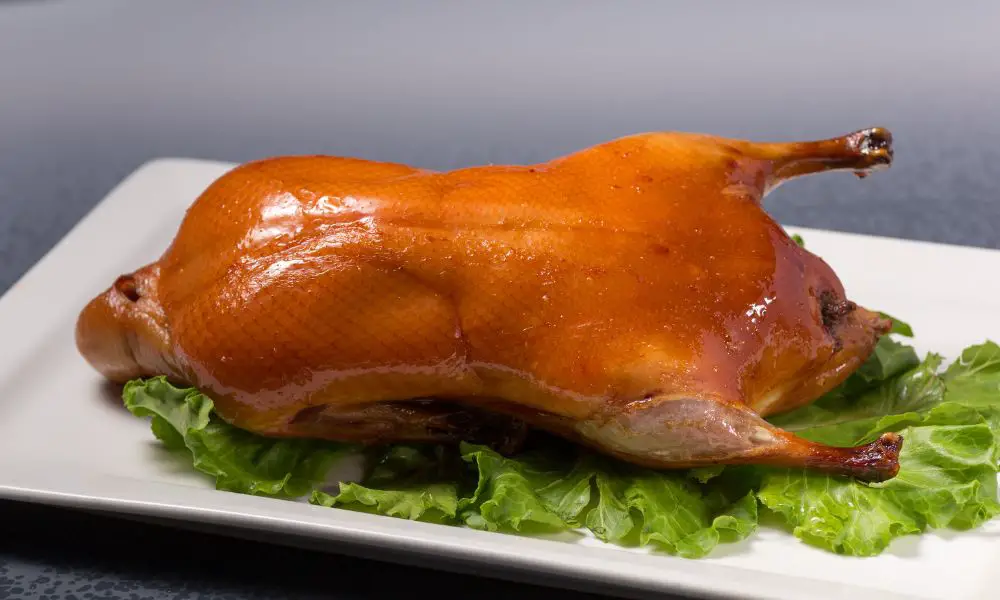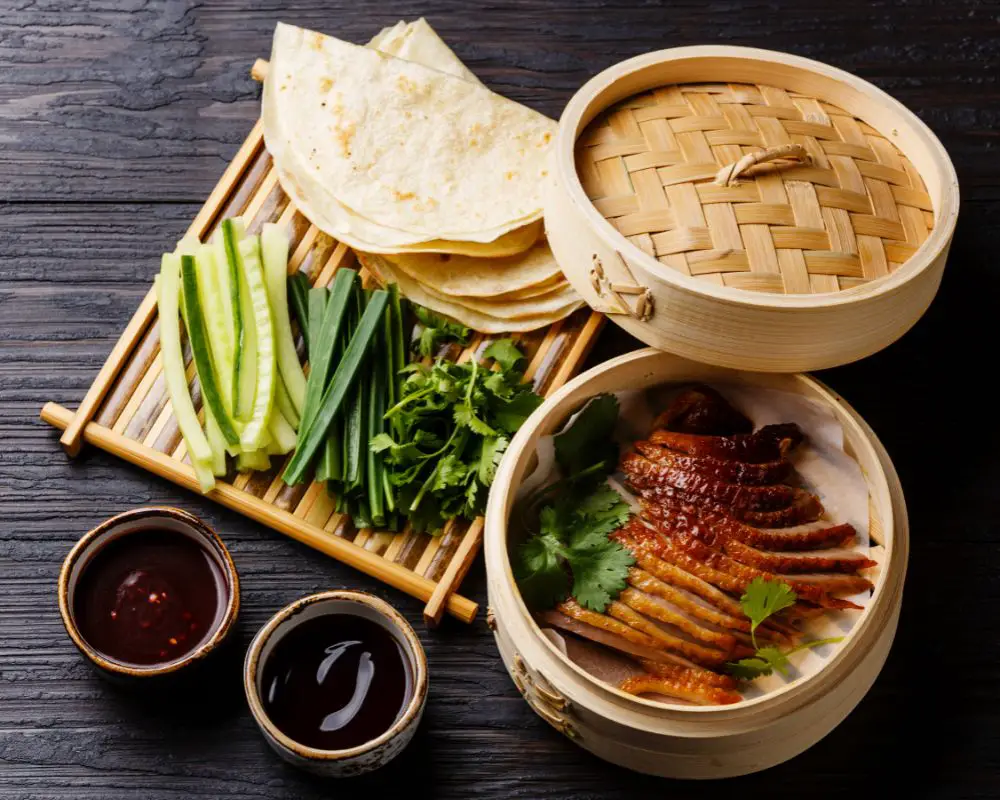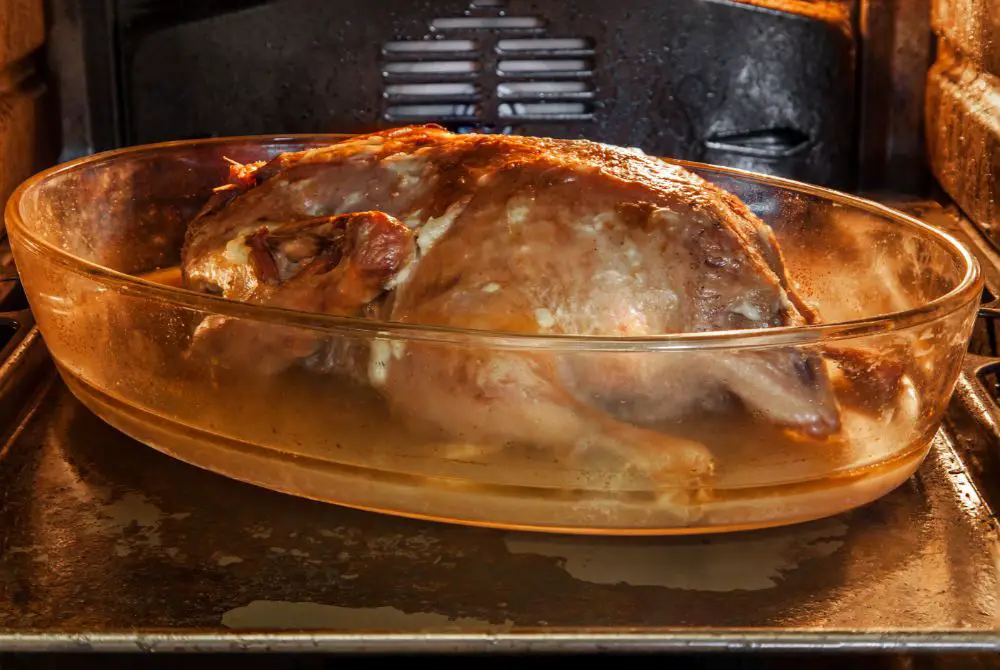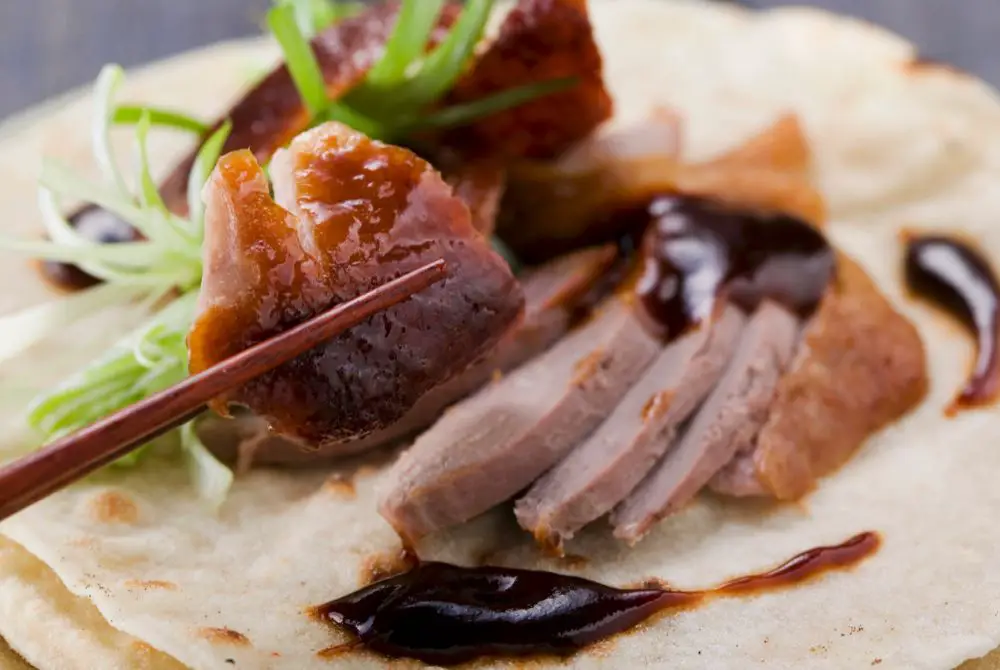
Are you ready for a taste adventure that will leave your taste buds singing? Look no further than Peking duck, one of the best Chinese foods in the world!
When you buy via links on our site, we may earn a small commission at no additional cost to you.
This world-renowned dish originating from Beijing, China is a culinary masterpiece that will tantalize your senses with its crispy skin, tender meat, and rich flavor.
Peking duck is a dish steeped in history and tradition, with a cooking method that involves roasting the duck to perfection in a special oven and seasoning it with a unique blend of spices and sauces.
Served with Chinese pancakes, scallions, cucumber, and hoisin sauce, every bite is an explosion of flavor that will have you craving more.
- Popular product: Best Water Filter for Home
- If it is a HOT and SUNNY day: Use This
- If it is a COLD and DRY season: Use This
- Keep hydrated with cold or hot water: Use This
Also, check out these Amazing Products For You!
Whether it’s for a special occasion or just a night in with friends, Peking duck is a dish that will leave a lasting impression and have everyone raving about your culinary skills.
So, it’s time to learn everything about Peking duck!
What is Peking Duck?

Peking duck is a Chinese dish that originated in Beijing and is known for its crispy skin and tender meat.
It is typically made using a white-feathered Pekin duck that has been seasoned with a mixture of spices and vinegar, and then roasted until the skin is crispy and golden brown.
The duck is traditionally served with thin pancakes, scallions, cucumber, and a sweet bean sauce or hoisin sauce for dipping.
The preparation of Peking duck is a complex and time-consuming process that involves several steps, including cleaning and seasoning the duck, hanging and drying the duck, and roasting it in a closed oven using a special technique.
The result is a dish that is both visually appealing and delicious, with a combination of textures and flavors that make it a popular and highly sought-after dish both in China and around the world.
Peking duck is considered one of China’s national dishes and is often served on special occasions such as weddings, banquets, and other celebratory events.
It is also a popular dish in Chinese restaurants around the world, and many chefs have put their own unique spin on the dish by incorporating local ingredients and flavors.
History of Peking Duck
Peking duck is a dish that has a long and rich history in China, particularly in the capital city of Beijing.
The origins of Peking duck can be traced back to the Yuan Dynasty (1271-1368), when it was known as “shao ya” and was served in the imperial court. However, it was during the Ming Dynasty (1368-1644) that the dish became more widely available and gained its current name, “Peking duck.”
During the Qing Dynasty (1644-1912), Peking duck became even more popular, with the opening of the famous Quanjude restaurant in Beijing in 1864.
Quanjude is credited with popularizing the dish and developing the traditional method of roasting the duck in a closed oven using fruitwood.
Today, Peking duck is considered one of China’s national dishes and is enjoyed by people all over the world. It continues to be served in high-end restaurants and has become a popular street food in China.
In recent years, there has also been a growing trend of vegetarian and vegan versions of Peking duck, which use ingredients like seitan, tofu, and mushrooms to recreate the dish’s texture and flavor.
Chinese Name of Peking Duck
The Chinese name of Peking Duck is 北京烤鸭, pronounced as “běi jīng kǎo yā”.
Peking Duck Taste & Texture: How Peking Duck Taste Like?
Peking duck has a unique and complex flavor profile that is both savory and slightly sweet.
The dish is known for its crispy skin and tender, succulent meat, which is seasoned with a mixture of spices and vinegar before being roasted until the skin is crispy and golden brown.
When you take a bite of Peking duck, you’ll first taste the crispy skin, which has a slightly sweet flavor and a crispy, crackly texture.
As you chew, the meat will be tender and juicy, with a rich, savory flavor that is enhanced by the spices used in the seasoning.
In a nutshell, Peking duck is a flavorful and satisfying dish that is beloved by people around the world. Its unique combination of textures and flavors make it a must-try for anyone who loves Chinese cuisine.
Accompaniments & Serving of Peking Duck

The dish is typically served with thin pancakes, scallions, cucumber, and a sweet bean sauce or hoisin sauce for dipping.
The pancakes provide a soft, slightly chewy contrast to the crispy skin and tender meat, while the scallions and cucumber add freshness and crunch to the dish.
The dipping sauce complements the savory flavor of the meat and helps to balance out the sweetness of the skin.
Variation of Peking Duck
While the traditional recipe for Peking duck involves roasting the whole duck with a special seasoning and serving it with pancakes and sauce, there are several variations of the dish that have emerged over the years.
Crispy Aromatic Duck
This variation of Peking duck is popular in the UK and involves seasoning the duck with Chinese five-spice powder and then deep-frying it until the skin is crispy. The duck is then served with pancakes, cucumber, and hoisin sauce.
Deboned Peking Duck
This variation involves removing the bones from the duck before roasting it, which makes it easier to eat and serve. The deboned duck is then served with thin pancakes, scallions, and hoisin sauce.
Vegetarian Peking Duck
This variation of Peking duck is made with seitan or tofu instead of duck meat. The seitan or tofu is seasoned and roasted in the same way as the traditional duck, and is then served with pancakes, scallions, and sauce.
Peking Duck Pizza
This is a fusion dish that combines Peking duck with pizza. The pizza is typically topped with hoisin sauce, cheese, and sliced Peking duck.
Peking Duck Wraps
This variation involves serving the duck meat and skin in lettuce wraps instead of pancakes. The lettuce wraps are usually filled with sliced duck meat, scallions, cucumber, and hoisin sauce.
These are just a few examples of the many variations of Peking duck that have emerged over the years. While some may stray from the traditional recipe, they all offer a unique and delicious twist on this iconic dish.
Preparation of Peking Duck

The preparation of Peking duck is a complex and time-consuming process that involves several steps.
The first step is to select a white-feathered Pekin duck, which is then cleaned, seasoned with a mixture of spices and vinegar, and left to air dry for several hours.
The duck is then roasted in a closed oven using a special technique that involves hanging the duck by its neck and rotating it to ensure that it is evenly cooked.
The result is a duck with a crispy, golden-brown skin and tender, succulent meat.
Ingredients for Peking Duck
The traditional recipe for Peking duck involves several key ingredients that give the dish its unique flavor and texture. Here are the main ingredients:
- Whole duck: The main ingredient in Peking duck is a whole duck that has been cleaned and prepared for roasting.
- Salt: The duck is typically rubbed with salt before being roasted to help enhance its flavor and texture.
- Maltose syrup: This is a key ingredient in the traditional seasoning for Peking duck. It is a type of sweet syrup made from malted barley that gives the duck skin its signature shiny appearance and sweet taste.
- Chinese five-spice powder: This is a blend of spices commonly used in Chinese cuisine, including cinnamon, star anise, cloves, fennel, and Szechuan peppercorns. It is used to season the duck before roasting.
- Scallions: Thinly sliced scallions are a traditional garnish for Peking duck and are typically served alongside the duck.
- Cucumber: Sliced cucumber is also served alongside the duck and helps balance out the rich flavor of the meat.
- Hoisin sauce: This is a sweet and savory sauce made from soybeans, sugar, vinegar, and various spices. It is typically used as a dipping sauce for Peking duck.
- Thin pancakes: These are thin, round pancakes made from flour and water that are used to wrap the duck meat and skin.
These are the main ingredients used in traditional Peking duck, although there may be variations depending on the specific recipe or cooking method used.
Tools Required to Prepare Peking Duck
Preparing Peking duck traditionally requires several specific tools to ensure the best results. Here are some of the tools you may need:
- Cleaver: A cleaver is used to remove the head and feet from the duck and to trim any excess fat.
- Pump: A pump is used to separate the skin from the meat of the duck, which helps to achieve a crispy skin.
- Hooks: Hooks are used to hang the duck during the roasting process.
- Closed oven: A closed oven is used to roast the duck at high temperature, typically using wood or charcoal.
- Brush: A brush is used to apply the maltose syrup to the duck before roasting.
- Scissors: Scissors are used to cut the duck into pieces before serving.
- Plates and platters: Plates and platters are used to serve the duck and accompanying ingredients, such as scallions, cucumber, and hoisin sauce.
Some variations of Peking duck may require different tools or equipment, such as a deep fryer for crispy aromatic duck or a pizza oven for Peking duck pizza. However, these are the main tools traditionally used to prepare Peking duck in the traditional manner.
Peking Duck Cooking Methods: The Crispy & Delicious Ways

Closed Oven Method for Peking Duck
There are several cooking methods used to prepare Peking duck, but the most traditional and popular method involves roasting the duck in a closed oven using a special technique. Here are the basic steps involved in this method:
- Cleaning and seasoning the duck: The first step is to clean and season the duck with a mixture of spices and vinegar. The spices used in the seasoning typically include cinnamon, star anise, ginger, and cloves, among others.
- Hanging and drying the duck: The duck is then hung by its neck and left to dry for several hours or overnight. This helps to remove excess moisture from the skin and ensures that it will become crispy when roasted.
- Roasting the duck: The duck is roasted in a closed oven at a high temperature for a period of time, typically around 45 minutes to an hour. During this time, the duck is rotated several times to ensure that it cooks evenly and the skin becomes crispy and golden brown.
- Serving the duck: The duck is traditionally served with thin pancakes, scallions, cucumber, and a sweet bean sauce or hoisin sauce for dipping.
Open Oven Method for Peking Duck
The open oven method is an alternative way of roasting Peking duck that is less traditional than the closed oven method, but still popular in some restaurants. Here are the basic steps involved in the open oven method:
- Cleaning and seasoning the duck: The first step is to clean and season the duck with a mixture of spices and vinegar. The spices used in the seasoning typically include cinnamon, star anise, ginger, and cloves, among others.
- Hanging and air-drying the duck: The duck is then hung by its neck and left to dry for several hours or overnight in a cool, ventilated area. This helps to remove excess moisture from the skin and ensures that it will become crispy when roasted.
- Preheating the oven: Preheat the oven to 200°C (400°F).
- Roasting the duck: Place the duck on a wire rack in the middle of the oven and roast it for 20 minutes on each side. While roasting, brush the duck with a mixture of honey and water to give it a shiny appearance and add flavor.
- Increase the oven temperature: After the first 40 minutes, increase the oven temperature to 220°C (425°F) and continue to roast the duck for another 10-15 minutes or until the skin is crispy and golden brown.
- Serving the duck: The duck is traditionally served with thin pancakes, scallions, cucumber, and a sweet bean sauce or hoisin sauce for dipping.
The open oven method is a quicker and more convenient way of roasting Peking duck compared to the closed oven method.
However, it may not produce the same level of crispiness and flavor as the traditional method.
Other Cooking Method for Peking Duck
Other cooking methods for Peking duck include:
- Smoking: Some chefs smoke the duck before roasting it to add flavor and complexity to the dish.
- Deep-frying: In some variations of the dish, the duck is deep-fried to create a crispy, crunchy texture.
- Sous-vide: Some chefs use the sous-vide cooking method to cook the duck in a vacuum-sealed bag at a low temperature before roasting it to achieve a tender, juicy texture.
Regardless of the cooking method, Peking duck is a dish that requires a lot of time and attention to detail to prepare correctly. When done well, it is a delicious and satisfying dish that is sure to impress.
Closed Oven vs Open Oven: The Differences of Peking Duck Cooking Methods
Peking duck can be cooked using both closed oven and open oven methods. Here are some differences between the two methods:
- Cooking Time: Closed oven method typically takes longer than the open oven method. The closed oven method requires the duck to be cooked for around an hour, while the open oven method can take as little as 30-40 minutes.
- Heat Distribution: In the closed oven method, the heat is distributed evenly around the duck as the oven is closed, resulting in a more evenly cooked and crispy duck. The open oven method, on the other hand, may not cook the duck as evenly, but may still produce a tasty and crispy result.
- Crispiness: The closed oven method is often preferred for producing a crispy and evenly cooked skin due to the fact that the duck is cooked in a closed and humid environment. The open oven method, while still producing a crispy skin, may not produce the same level of crispiness and texture as the closed oven method.
- Tradition: The closed oven method is the more traditional way of cooking Peking duck, and is still widely used in China and other countries. The open oven method, while also popular, is a more modern adaptation of the dish.
Ultimately, the choice between the two methods depends on personal preference and the equipment available. Both methods can produce a delicious and satisfying Peking duck when done correctly.
Peking Duck Recipes: How to Make Peking Duck at Home

Here are two common recipes for making Peking duck at home:
Peking Duck Recipe 1: Traditional Peking Duck
Ingredients:
- 1 whole duck (5-6 pounds)
- 1/2 cup honey
- 1/2 cup soy sauce
- 1/4 cup hoisin sauce
- 1/4 cup rice vinegar
- 2 tablespoons sherry or rice wine
- 2 tablespoons sesame oil
- 2 tablespoons five-spice powder
- 1 bunch of scallions
- 1 cucumber
- 20-30 small Chinese pancakes
- Hoisin sauce for serving
Instructions:
- Begin by cleaning the duck and removing any excess fat from the cavity. Rinse the duck inside and out with cold water and pat dry.
- In a small bowl, mix together the honey, soy sauce, hoisin sauce, rice vinegar, sherry or rice wine, sesame oil, and five-spice powder to make a marinade.
- Brush the marinade all over the duck, making sure to coat both the inside and outside. Stuff the duck with the bunch of scallions and seal the cavity with toothpicks.
- Place the duck on a wire rack in a roasting pan and let it dry for at least 2 hours or overnight in the refrigerator.
- Preheat your oven to 375°F. Roast the duck for about 1 hour and 15 minutes or until the skin is crispy and golden brown.
- Remove the duck from the oven and let it cool for about 10 minutes. Then, use a cleaver or sharp knife to carve the duck into thin slices.
- Serve the duck with Chinese pancakes, sliced cucumber, scallions, and hoisin sauce.
Note: To achieve a more authentic Peking duck flavor, some recipes call for air-drying the duck before roasting it. This can be done by hanging the duck in a cool, dry place for several hours to dry out the skin.
Peking Duck Recipe 2: Crispy Aromatic Duck
Ingredients:
- 1 whole duck, cleaned and prepared
- Salt
- 2 teaspoons five-spice powder
- 1 tablespoon honey
- 1 tablespoon soy sauce
- 1 tablespoon Shaoxing wine
- 1 tablespoon hoisin sauce
- 1 tablespoon brown sugar
- 1/2 teaspoon sesame oil
- 2 tablespoons vegetable oil
- Thin pancakes
- Sliced scallions
- Sliced cucumber
Instructions:
- Preheat a deep fryer to 375°F (190°C).
- Rub the duck inside and out with salt and five-spice powder.
- In a small bowl, mix together the honey, soy sauce, Shaoxing wine, hoisin sauce, brown sugar, sesame oil, and vegetable oil.
- Brush the honey mixture over the duck, making sure to coat it evenly.
- Place the duck in the fryer and cook for 20 minutes, or until the skin is crispy and golden brown.
- Remove the duck from the fryer and let it rest for at least 10 minutes before carving.
- Serve the duck with thin pancakes, sliced scallions, and sliced cucumber.
Both of these recipes are delicious and authentic ways to prepare Peking duck. Enjoy!
Tips for Delicious & Crispy Peking Duck
Preparing Peking duck can be a bit tricky, but with the right techniques and tips, you can achieve delicious results. Here are some tips for making the perfect Peking duck:
Choose A High-quality Duck
The quality of the duck you use will affect the final result. Look for a fresh, plump duck with a good layer of fat and skin.
Dry The Duck Before Roasting
After rinsing the duck, dry it thoroughly inside and out using paper towels. This will help the skin become crispy during roasting.
Pump Air Under The Skin
Use a pump to separate the skin from the meat of the duck, which helps to achieve a crispy skin. Be careful not to puncture the skin.
Hang The Duck To Dry
After seasoning the duck with maltose syrup and spices, hang it in a cool, dry place for several hours or overnight. This will help to dry out the skin and enhance its crispiness.
Use A Closed Oven
Use a closed oven to roast the duck at high temperature. This will help to ensure even cooking and a crispy skin.
Baste The Duck Regularly
While roasting, baste the duck with the remaining maltose syrup mixture every 10-15 minutes. This will help to enhance the flavor and texture of the duck.
Let The Duck Rest Before Carving
After roasting, let the duck rest for at least 10 minutes before carving. This will help the juices distribute evenly and make it easier to carve.
Serve With Traditional Accompaniments
Serve the duck with thin pancakes, sliced scallions, cucumber, and hoisin sauce for the traditional Peking duck experience.
By following these tips, you can achieve a delicious and authentic Peking duck that will impress your family and friends.
Peking Duck Nutrition
Peking duck is a delicious and popular dish, but it is also high in fat and calories. Here is the approximate nutrition information for one serving (3.5 ounces or 100 grams) of Peking duck:
- Calories: 280
- Fat: 21 grams
- Carbohydrates: 0 grams
- Protein: 21 grams
As you can see, Peking duck is high in calories and fat, primarily due to the duck’s skin. However, it is also a good source of protein. Consuming Peking duck in moderation as part of a balanced diet can be enjoyed without compromising overall health.
It’s worth noting that the nutrition information can vary depending on the specific recipe used to prepare Peking duck, as well as the serving size and additional ingredients used to serve the dish, such as pancakes and sauces.
Reheating The Peking Duck
Reheating Peking duck can be a bit tricky, as you want to maintain the crispy skin while ensuring that the meat is heated through. Here’s one method for reheating Peking duck:
- Preheat your oven to 350°F (175°C).
- Remove the duck from the refrigerator and let it come to room temperature for about 30 minutes.
- Place the duck on a roasting rack, breast-side up, and cover it with aluminum foil.
- Roast the duck in the preheated oven for about 15-20 minutes, or until heated through.
- Remove the foil and increase the oven temperature to 425°F (220°C).
- Roast the duck for another 5-10 minutes, or until the skin is crispy and golden brown.
- Remove the duck from the oven and let it rest for a few minutes before carving and serving.
You can also reheat individual slices of duck in a skillet over medium heat. Place the slices skin-side down and cook for a few minutes, or until the skin is crispy and the meat is heated through.
Remember to store any leftover duck in an airtight container in the refrigerator and consume it within 2-3 days. Reheating Peking duck is not as good as freshly cooked, but following these steps should help you to maintain the flavor and texture of the dish.
What is the Price of Peking Duck?
The price of Peking duck can vary depending on where you are purchasing it from and the quality of the duck.
In upscale restaurants, the price can be quite high, ranging from $50-$100 or more per duck.
However, in more casual or local restaurants, the price can be more affordable, typically ranging from $20-$40 per duck.
Additionally, you can also find Peking duck sold in specialty Asian markets or online, where the price can vary based on the supplier and the quality of the duck.
Overall, the price of Peking duck can vary widely, and it’s best to shop around to find the best value for your budget.
FAQ for Peking Duck
Here are some frequently asked questions about Peking duck:
What is the best way to serve Peking duck?
Peking duck is typically served with thin pancakes, scallions, cucumber, and a sweet bean sauce. To serve, you should spread some sauce onto a pancake, add a slice of duck, some scallions and cucumber, then roll it up and enjoy.
Can I make Peking duck at home?
Yes, Peking duck can be made at home, but it can be a time-consuming and challenging process. It requires a specific technique to achieve the crispy skin and tender meat. There are many recipes and methods available online that can guide you through the process.
How do I store leftover Peking duck?
Leftover Peking duck should be stored in an airtight container in the refrigerator and consumed within 2-3 days. Reheating leftover Peking duck can be a bit tricky, as you want to maintain the crispy skin while ensuring that the meat is heated through.
Is Peking duck healthy?
Peking duck is high in calories and fat, primarily due to the duck’s skin. However, it is also a good source of protein. Consuming Peking duck in moderation as part of a balanced diet can be enjoyed without compromising overall health.
Where can I find Peking duck?
Peking duck is a popular dish in many Chinese restaurants worldwide. You can also find it in some specialty Asian markets or order it online from retailers that specialize in Chinese cuisine.
Peking Duck: One of the Best Chinese Foods in The World
Peking duck is a delicious and iconic dish that originated in Beijing, China. It is prepared by cleaning, seasoning, and roasting a whole duck in a special oven, resulting in crispy skin and succulent meat. Peking duck is traditionally served with thin pancakes, scallions, cucumber, and a sweet bean sauce or hoisin sauce for dipping.
While there are variations in the cooking methods used to prepare Peking duck, the most traditional method involves roasting the duck in a closed oven using a special technique. The open oven method is also popular and can produce a delicious and crispy result.
Peking duck is not only a delicious dish but also a cultural experience that has been enjoyed for centuries.
Today, it is popular around the world and is often served in high-end Chinese restaurants. Whether prepared using traditional or modern techniques, Peking duck is a must-try dish for any food lover.
Read Next:
